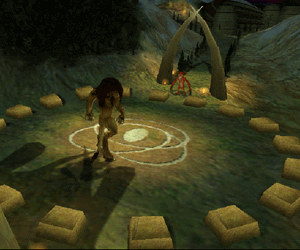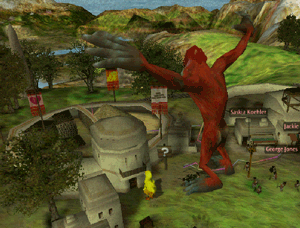Review: Black & White: Platinum Pack

Developer: Lionhead Studios Ltd., published by Feral Interactive Ltd. and Graphic Simulations, distributed by MacPlay.
Price: $49.99
Requirements: 333 MHz Mac with Mac OS 9.1 or Mac OS X 10.1.3, 128 MB of RAM, 1.5 GB disk space, 8 MB 3D accelerator with OpenGL 1.2, 4x CD-ROM.
Recommended: Mac OS 9.2.2 or Mac OS X 10.2, 500 MHz, 256 MB of RAM, 32 MB 3D accelerator with OpenGL.
Trial: None
Overview
The Black & White Platinum Pack contains the original Black & White and its immediate offspring, the expansion game Creature Isle. Real-time strategy with a twist, Black & White challenges you to build and expand a godly empire. The “twist” is a creature, your creature, a minion who learns and grows, eventually becoming your primary force in the surrounding lands. The colors “black” and “white” indicate your ability to choose between styles of play. Teach your creature to love the inhabitants or terrorize them. Either will build belief, your source of power in the game’s land. You eventually face off against other gods and creatures, seeking to prove your superiority.
The original Black & White starts with an infant creature and a single city of believers. Through a series of tutorial exercises, you learn how to interact with each by performing miracles and finishing tasks. Neighboring gods and periodic trials test your creature’s education and combat skills. With sufficient education and power, the creature can dominate the entire land and its population.
Black & White supports network and Internet play, pitting your creature and empire skills against other human players. Game play is functionally the same for both, but multi-player games have specific, competitive goals.
ATPM reviewed the original Black & White in issue 8.05. Since I largely agree with its content, this review focuses on the Creature Isle expansion in single-player mode.
Installation
The Black & White installer creates a single folder in the Applications folder. The game and all the data files go there. MacPlay publishes updates for Black & White, available from their site or through a site like VersionTracker. As of this article, 1.1.9 is the latest update.
Creature Isle requires the original Black & White game, so install it (and play it) first. You don’t need to finish Black & White to play Creature Isle, but it helps. Take your creature from Black & White into Creature Isle, or start an expansion game and use the provided monkey creature.
Game Play
Black & White breaks no real ground in world building. You assemble resources and build cities, balancing conservation, expansion, and defense. Your followers’ belief gives you power to build additional homes and other buildings, which increase the population and its belief. Miracles use belief power to create raw materials or change the landscape. Eventually, your empire expands to cities and the cycle begins again. Your home Tower tracks acquired game knowledge and tasks performed, serving as a reference and refuge.
There are two notable innovations in Black & White. First is your interaction with the creature. It learns what you choose to teach it, by example and reinforcement. With proper care, it will control your village and conquer neighboring lands. Second is your option to walk the path of aggression or the way of compassion. Terror and providence are both legitimate methods of exercising your power and instructing your creature. Teaching your creature to defend itself and overcome challenges is the key to playing—and enjoying—Black & White.
Creature Isle starts on an island without gods, inhabited by several tribes. Missionaries from your original tribe land on its shores and convert an Egyptian city that becomes your home. The island is also home to a band of masterless creatures called the Brotherhood. The head of the Brotherhood, Rufus, talks to your creature and announces a series of trials to earn membership. (They don’t give Rufus’ last name, but I suspect it’s “Exposition.”)

My creature meets with Rufus for the first time.
Along the way, your creature acquires its own pet to instruct. The pet, a chicken named Tyke (not Tyson?), follows your creature around, mimicking its actions and learning what it knows. This teaching-the-teacher task shifts the focus somewhat, making you more directly active in helping your creature pass along its knowledge appropriately. This two-pronged approach to creatures is interesting, but ultimately can be as frustrating as satisfying. (“Come ON!” I wanted to shout a couple of times. “The MONKEY gets it, why don’t YOU?”)

My creature gets his own pet chicken.
The Brotherhood trials require the most “work,” as you essentially make decisions for your creature or otherwise best another animal at its chosen game. Finish a trial and you can switch to that animal (or fight it) at the Dojo, the Brotherhood’s home. Complete the trials and conquer the island to meet Eve, an enigmatic member of the Brotherhood.
Play Control
Those who played Myth will recognize Black & White’s play control. You see the three-dimensional landscape from overhead as a god might. Move from place to place and change perspective with the mouse, but keep the other hand on the keyboard shortcuts. The on-screen hand is a proxy—your “hand of god”—interacting with objects and performing miracles. Use leashes to guide or instruct your creature in correct behavior. Erect new city buildings by gathering supplies and designating town workers. (“I must build a soccer field. God told me to.”)

My “bad” spirit advisor tells me that Shadrin, the town leader, wants to ask a favor.
Though better for people with multi-button mice, play control is cumbersome at best. You can pause the game frequently to make specific decisions without the pressure of time, but you quickly lose game flow. The concept of mouse “gestures” helps for casting miracles, but there’s still a lot going on. It’s hard to feel “in control” of your creatures and followers. I expect this isn’t a problem for experienced real-time strategists, but it kept me from enjoying the game. Most new tasks felt like pulling one of my creature’s teeth.

My creature teaches Tyke how to use the Village Store.
In short, why am I doing all this work? Shouldn’t my creature be The Man, or at least The Monkey? There’s too much reliance on human interaction to get your creatures working properly with the trials and villagers. It works in Myth because your creatures run largely on automatic. Creature Isle suffers from getting cute with the original idea, teaching a computer how to behave like a civilized (or spiteful) creature.
Settings
There are many video and audio settings, and the video resolution and details settings impact game play most. My slower 450 MHz CPU and built-in 3D card meant that 800x600 was the maximum video setting. Anything higher would have slowed play to a crawl when I moved around the city. Players with faster CPUs and better 3D graphics cards can exploit much higher settings.
Tips
You can “cheat” at many trials to make them easier—but is it cheating when you’re a god? In the bowling trial, for example, keep a stash of rocks near (but not too near) the trial logo. When your creature bowls, grab a rock and drop it on pins to knock them down. When the other creature bowls, drop a rock in front of his ball to knock it away. Look for similar opportunities to use miracles or other abilities to outfox the trial designers. The trials are like a collection of party games. Don’t take them too seriously, but definitely finish them as soon as practical to expand your roster of creatures.
Bugs
The first time I played Creature Isle, there was no video but I could hear the introduction playing in the background. After installing the 1.1.9 update, the video worked properly.
Summary
The ATPM review of the original Black & White rated it “Okay.” Creature Isle plays Jeff Daniels to its Jim Carrey and gets an “Okayer.” Leaning on direct human interaction, given its sluggish interface, wasn’t a great idea. Hopefully Black & White 2 will improve the latter or eschew the former.
Black & White aficionados will probably enjoy Creature Isle’s variety of available creatures and added challenge of teaching your creature to teach. Casual players may think, “I should just play the first game again and try being bad this time.”
Reader Comments (10)
Add A Comment